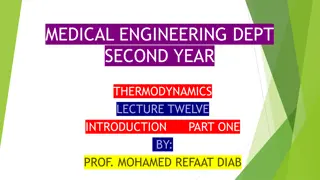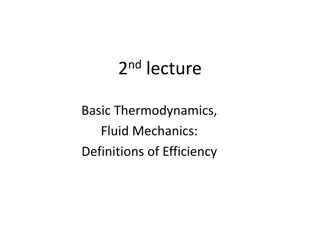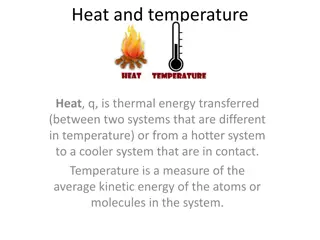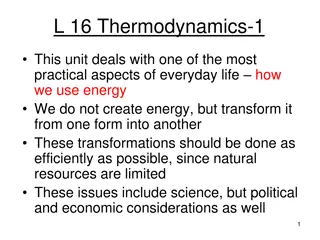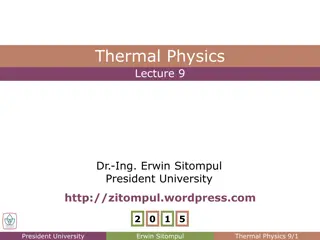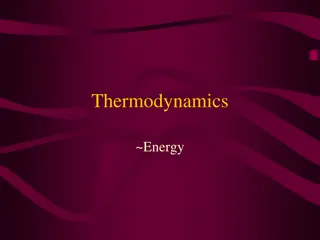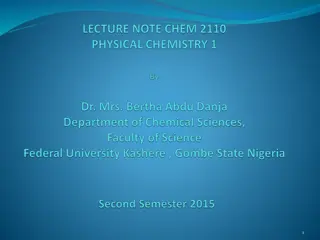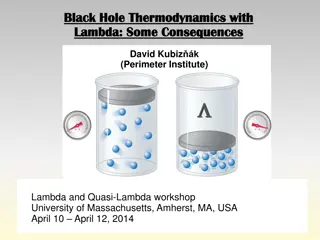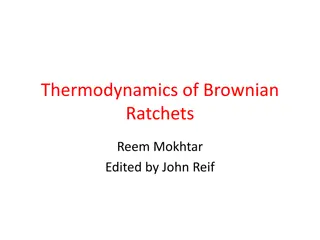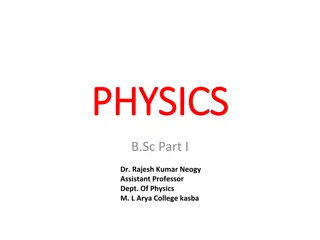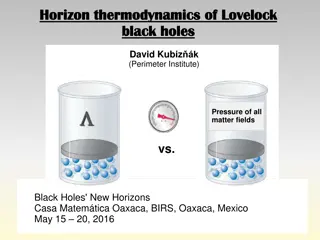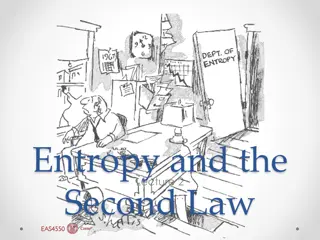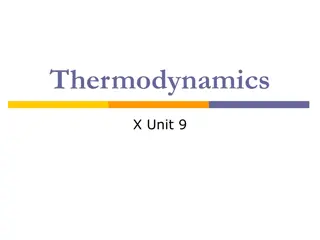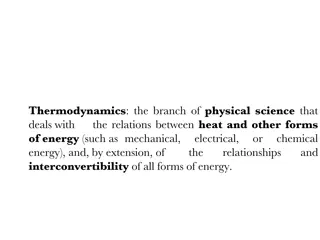Thermodynamics of Materials: Experimental Verification and Entropy Analysis
Verification of the Third Law of Thermodynamics through the study of phase transitions in elements like sulfur, exemplifying the relationship between heat capacity, enthalpy, entropy, and the Third Law. Experimental data on entropy changes and molar entropies, as well as insights into the behavior of materials at different temperatures, further support thermodynamic principles. The significance of entropy in determining material characteristics and transitions is highlighted.
Download Presentation

Please find below an Image/Link to download the presentation.
The content on the website is provided AS IS for your information and personal use only. It may not be sold, licensed, or shared on other websites without obtaining consent from the author.If you encounter any issues during the download, it is possible that the publisher has removed the file from their server.
You are allowed to download the files provided on this website for personal or commercial use, subject to the condition that they are used lawfully. All files are the property of their respective owners.
The content on the website is provided AS IS for your information and personal use only. It may not be sold, licensed, or shared on other websites without obtaining consent from the author.
E N D
Presentation Transcript
Heat Capacity, Enthalpy, Entropy, and the Third Law of Thermodynamics 149 6.6 EXPERIMENTAL VERIFICATION OF THE THIRDLAW The Third Law can be verified by considering a phase transition in an element such as where a and are allotropes of the element. In Fig. 6.11 Ttransis the temperature, at atmospheric pressure, at which the a and phases are in equilibrium with one another. For the cycle shown in Fig. 6.11 For the Third Law to be obeyed, OSIV=0, which requiresthat where OSII, which is called the experimental entropy change, and (OSI+OSIII), which is called the Third Law entropy change, are equal to one another if the Third Law is obeyed.
150 Introduction to the Thermodynamics ofMaterials Figure 6.11 The cycle used for the experimental verification of the Third Law of Thermodynamics. The cycle shown in Fig. 6.11 has been examined for the case of sulfur, which has two allotropes; a monoclinic form which is stable above 368.5 K and an orthorhombic form whichis stable below 368.5 K, with a molar latent heat of transformation of 400 J/mole at the equilibri- um transformation temperature of 368.5 K. As monoclinic sulfur can be supercooled with relative ease, the variations, with temperature, of the heat capacities of both allotropes have been measured experimentally at temperatures below 368.5 K. The measured heat capacities give and
Heat Capacity, Enthalpy, Entropy, and the Third Law of Thermodynamics 151 Thus and As the difference between the experimental and the Third Law entropy changes is less than the experimental error, the equality is taken as being experimental verification of the Third Law. Assigning a value of zero to S0 allows the absolute value of the entropy of anymaterial to be determined as and molar entropies are normally tabulated at 298 K, where The variations, with temperature, of the molar entropies of several elements and compounds are shown in Fig. 6.12. With the constant-pressure molar heat capacity of the solid expressed in the form the molar entropy of the solid at the temperature T is obtainedas
152 Introduction to the Thermodynamics ofMaterials Figure 6.12 The variation, with temperature, of the molar entropies of several elements and compounds. At temperatures higher than the melting temperature, Tm, the molar entropy of the liquid is obtained as where the molar entropy of the melting, OSm, is obtained as OHm/Tm. In 1897 Richards suggested that the entropies of fusion of metals should have the same value, which would require that a plot of OHmvs. Tmbe a straight line. Fig. 6.13 is a plot of the molar enthalpies of fusion vs. the melting temperatures of 11 face-centered cubic metals (open circles) and 27 body-centered cubic metals (closed circles) which have melting temperatures below 3000 K. A least-squares analysis of the data for the face- centered cubic metals gives
Heat Capacity, Enthalpy, Entropy, and the Third Law of Thermodynamics 153 and the corresponding equation for the body-centered cubic metals is The slopes of the lines indicate that the molar entropy of melting of face-centered cubic (FCC) metals is approximately 9.6 J/K and that of body-centered cubic (BCC) metals is approximately 8.3 J/K, although the scatter in the data for BCC metals is Figure 6.13 An illustration of Richard s rule. much greater than that for FCC metals. This observation, which is known as Richards s rule, indicates that the difference between the degree of disorder in the liquid structure and that in both the FCC and BCC crystal structures is approximately the same for all FCC and BCC metals. Trouton s rule states that the molar entropy of boiling of a liquid metal is 88 J/K. Fig. 6.14 shows a plot of OHbvs. the boiling temperature, Tb, for 29 liquid metals with boiling temperatures below 4000 K. A least-squares fit of the data, shown as the full line, gives However, a least-squares fit of the data for the 13 metals with boiling temperatures below 2100 K, shown as the broken line, gives
154 Introduction to the Thermodynamics ofMaterials which indicates a common molar entropy of boiling of approximately 87 J/K for these metals. Figure 6.14 An illustration of Trouton s rule. Figure 6.15 is the entropy-temperature diagram for thereaction corresponding to the enthalpy-temperature diagram shown in Fig. 6.7. Because of the similar magnitudes of the molar entropies of the condensed phases Pb and PbO, it is seen that the entropy change for the reaction, is very nearly equalto . For example, at 298K
Heat Capacity, Enthalpy, Entropy, and the Third Law of Thermodynamics 155 which is similar in magnitude to the decrease in entropy caused by the disappearance of mole of oxygen gas. This approximation is generally valid; i.e., in reactions in which a gas reacts with a condensed phase to produce another condensed phase, the change in the entropy is of similar magnitude to that caused by the disappearance of the gas. Figure 6.15 The variation, with temperature, of the entropies of Pb(s), Pb(l), PbO(s), , and the entropy change for the reaction . 6.7 THE INFLUENCE OF PRESSURE ON ENTHALPY ANDENTROPY For a closed system of fixed composition undergoing a change of pressure at constant temperature,
156 Introduction to the Thermodynamics ofMaterials Eq. (5.10) gives dH=TdS+VdP, and thus Maxwell s equation (5.34) gives (6S/6P)T= (6V/6T)P, in which case The isobaric coefficient of thermal expansion, a, is definedas andthus The change in molar enthalpy caused by the change in state from (P1, T) to (P2, T) is thus (6.14) For an ideal gas, a=1/T, and thus Eq. (6.14) shows again that the enthalpy of an ideal gas is independent of pressure. The molar volume and expansivity of Fe are, respectively, 7.1 cm3and 0.3 10 4K 1. Thus an increase in the pressure exerted on Fe from 1 to 100 atm at 298 K causes the molar enthalpy to increase by The same increase in molar enthalpy would be obtained by heating Fe from 298 to 301 K at 1 atm pressure.
Heat Capacity, Enthalpy, Entropy, and the Third Law of Thermodynamics 157 For a closed system of fixed composition undergoing a change of pressure at constant temperature, Maxwell s equation (5.34) is (6S/6P)T= (6V/6T)p which, with the definition of a, gives Thus, for the change of state (P1, T) to (P2, T) (6.15) For an ideal gas, as a=1/T, Eq. (6.15) simplifiesto as was obtained in Sec. 3.7. An increase in the pressure exerted on Fe from 1 to 100 atm decreases the molar entropy by 0.0022 J/K, which is the same as is obtained by decreasing the temperature by 0.27 degrees from 298 K at 1 atm pressure. It is thus seen that the molar enthalpies and entropies are relatively insensitive to changes in pressure. In the majority of materials applications, in which the the range of pressure is 0 to 1 atm, the influence of pressure on the enthalpies and entropies of condensed phases can be ignored. For a closed system of fixed composition undergoing changes in both pressure and temperature, combination of Eqs. (6.1) and (6.14) gives (6.16)
158 Introduction to the Thermodynamics ofMaterials and combination of Eqs. (6.12) and (6.15) gives (6.17) Just as it was required that the temperature dependence of Cp be known for integration of Eqs. (6.1) and (6.13), strictly, it is required that the pressure dependence of V and a be known for integration of Eqs. (6.14) and (6.15). However, for condensed phases being considered over small ranges of pressure, these pressure dependencies can be ignored. 6.8 SUMMARY Knowledge of the heat capacities and the entropies of substances and the heats of formation of compounds allows enthalpy and entropy changes to be evaluated for any process, i.e., for phase changes and chemical reactions. As enthalpy does not have an absolute value, it is conventional to assign the value of zero to the enthalpy of all elements in their stable states of existence at 298 K and to consider changes in enthalpy with respect to this reference state. In contrast, entropy has an absolute value, and the entropy of all substances which are in complete internal equilibrium is zero at 0 K. Although both enthalpy and entropy are dependent on pressure and temperature, the dependence of the enthalpy and entropy of condensed phases is normally small enough to be ignored when the pressure of interest is in the range 0 1atm. The determination of OHTand OSTfor any change of state at any temperature and pressure allows the all-important change in the Gibbs free energy for the change of state to be calculated as As consideration of the Gibbs free energy in any isothermal, isobaric process provides the criterion for equilibrium, the equilibrium state of a system can be determined from a knowledge of the thermochemical properties of the system. 6.9 NUMERICALEXAMPLES Example 1 Uranium can be produced by reacting a uranium-bearing compound with a more reactive metal, e.g., Mg can be used to reduce UF4according to thereaction This reaction is exothermic, and the sensible heat released is used to increase the temperature of the reaction products. In order to facilitate a good separation of the Ufrom
Heat Capacity, Enthalpy, Entropy, and the Third Law of Thermodynamics 159 the MgF2, it is desirable to produce them as liquids (which are immiscible). If the reactants are placed in an adiabatic container in the molar ratio Mg/UF4=2.0 and are allowed to react completely at 298 K, is the quantity of sensible heat released by the reaction sufficient to increase the temperature of the reaction products to 1773 K? The required thermochemical data are The heat released by the reaction occurring at 298 K is thus Calculation of the amount of heat required to increase the temperature of the products from 298 to 1773 K requires knowledge of the constant-pressure molar heat capacities and the changes in enthalpy caused by any phase transformations. These data are 3 6 2 C p,U(a)=25.10+2.38 10 T+23.68 10 T J/K in the range 298 941 K Cp,U( )=42.93 J/K in the range 941 1049 K Cp,U( )=38.28 J/K in the range 1049 1408K Cp,U(l)=48.66 J/K C p,MgF2(s)=77.11+3.89 10 T 14.94 10 T Cp,MgF2(l) =94.56 J/K 3 5 2 in the range 298 1536 K For U(a) U( ), OHtrans=2800 J at Ttrans=941 K For U( ) U( ), OHtrans=4800 J at Ttrans=1049 K For U( ) U(l), OHm=9200 J at Tm=1408 K For MgF2,(s) MgF2,(l), OHm=58,600 J at Tm=1536K The heat required to increase the temperature of 1 mole of U from 298 to 1773 K is
160 Introduction to the Thermodynamics ofMaterials Thus The heat required to increase the temperature of 2 moles of MgF2 from 298 to 1773 Kis The total heat required isthus which is more than is made available by the exothermic reaction. The actual temperature attained by the adiabatically contained reaction products is calculated as follows: Assume that the temperature attained is at least 941 K. The heat required to raise the temperature of 1 mole of U(a)and 2 moles of MgF2from 298 to 941is
Heat Capacity, Enthalpy, Entropy, and the Third Law of Thermodynamics 161 which is less than the 328,800 J released by the exothermic reaction. Assume, now, that the temperature attained is at least 1049 K. The heat required to transform 1 mole of U from a to at 941 K and heat 1 mole of U( )and 2 moles of MgF2from 941 to 1049 K is Heating to 1049 K consumes 118,866+24,601=143,467 J, which leaves 328,800 143,467=185,333 J of sensible heat available for further heating. Assume that the temperature attained is at least 1408 K. The heat required to transform 1 mole of U from to at 1049 K and increase the temperature of 1 mole of U( )and 2 moles of MgF2 from 1049 K is
162 Introduction to the Thermodynamics ofMaterials To reach 1409 K, requires 143,467+76,692=220,079 of the available heat, which leaves 108,721 J for further heating. Assume that the temperature reaches 1536 K. The heat required to melt 1 mole of U at 1408 K and increase the temperature of 1 mole of liquid U and 2 moles of MgF2from 1408 to 1536 Kis To reach 1536 K thus requires 220,079+36,457=256,536 J, which leaves 108,271 36,457=71,814 J. The remaining sensible heat is less than the heat of melting of two moles of MgF2, (OHm=58,600J), and thus is used to melt moles of MgF2 at its melting temperature of 1536 K. The reaction products are thus liquid U, liquid MgF2, and solid MgF2 occurring in the ratio 1:1.23:0.77 at 1536K. The attainment, by the reaction products, of a final temperature of 1773 K requires that an extra 101,264 J be supplied to the adiabatic reaction container, and this is achieved by preheating the reactants to some temperature before allowing the reaction to occur. The required temperature, T,is obtained from Assume that T is less than the melting temperature of Mg, TMg(m)=923 K. The required thermochemical data are 3 5 2 Cp,Mg=21.12+11.92 10 T+0.15 10 T =107.53+29.29 10 3T 0.25 105T 2 in the range 298 1118 K in the range 298 923K
Heat Capacity, Enthalpy, Entropy, and the Third Law of Thermodynamics 163 Thus which has the solution T=859 K, which is less than the melting temperature of Mg. Thus in order to produce liquid U and liquid MgF2 at 1773 K, the stoichiometric reactantsmust be preheated to 859 K. The enthalpy-temperature diagram for the process is shown in Fig. 6.16. Taking the relative zero of enthalpy to be represents the influence of the supply of 101,264 joules of heat to 1 mole of UF4 and 2 moles of Mg, which is to increase the temperature of the system from 298 to 859 K. the line ab
164 Introduction to the Thermodynamics ofMaterials Figure 6.16 The enthalpy-temperature diagram considered in Example 1. At the point b the reactants are placed in an adiabatic container and are allowed to react completely, which causes the change in enthalpy The reaction causes the enthalpy to decreases from b to c and the sensible heat produced increases the temperature of the products along cl. The line contains four jogs; ed at 941
Heat Capacity, Enthalpy, Entropy, and the Third Law of Thermodynamics 165 K (for the heat of transformation of a U to U), fg at 1049 K (the heat of transformation of U to U), hi at 1409 K (the heat of melting of U), and kj at 1536 K which represents the heat of melting of 2 moles of MgF2. As the reaction has been conducted adiabatically, Hi=Hb. In practice the system does not follow the line b c l, which would require that all of the heat of the reaction be released isothermally before being made available to increase the temperature of the products. In practice the temperature of the system begins to increase as soon as the reaction begins, but, as enthalpy is a state function, the difference between its value in state 1 and its value in state 2 is independent of the process path taken by the system between the states. Example 2 A mixture of Fe2O3and Al, present in the molar ratio 1:2, is placed in an adiabatic container at 298 K, and the Thermit reaction is allowed to proceed to completion. Calculate the state and the temperature of the reaction products. From the thermochemical data and the heat released by the Thermit reaction at 298 K is calculated as and this heat raises the temperature of the reaction products. Assume, first, that the sensible heat raises the temperature of the products to the melting temperature of Fe, 1809 K, in which state the reactants occur as 2 moles of liquid Fe and 1 mole of solid Al2O3. The molar heat capacities and molar heats of transformation are =117.49+10.38 10 3T 37.11 105T 2 J/K in the range 298 2325K 3 0.5 Cp,Fe(a)=37.12+6.17 10 T 56.92T 3 Cp,Fe( )=24.48+8.45 10 T in the range 1187 1664 K 3 0.5 Cp,Fe(6)=37.12+6.17 10 T 56.92T J/K in the range 298 1187 K J/K in the range 1667 1809 K
166 Introduction to the Thermodynamics ofMaterials For Fe(a) Fe( ), OHtrans=670 J at 1187 K For Fe( ) Fe(6), OHtrans=840 J at 1664 K For Fe(6) Fe(l), OHm=13,770 J at 1809 K The heat required to raise the temperature of 1 mole of Al2O3 from 298 to 1809 Kis and the heat required to raise the temperature of 2 moles of Fe from 298 to 1809 K and melt the 2 moles at 1809 K is The total heat required isthus The remaining available sensible heat is 852,300 341,190=511,110 J. Consider that the remaining sensible heat raises the temperature of the system to the melting temperature of Al2O3, 2325 K, and melts the mole of Al2O3. The heat required to increase the temperature of the mole of Al2O3is
Heat Capacity, Enthalpy, Entropy, and the Third Law of Thermodynamics 167 and, with Cp,Fe(l)=41.84 J/K, the heat required to increase the temperature of the 2 moles of liquid Fe is The molar latent heat of melting of Al2O3 at its melting temperature of 2325 K is 107,000 J, and thus the sensible heat consumed is which still leaves 511,110 221,418=289,692 J of sensible heat. Consider that this is sufficient to raise the temperature of the system to the boiling point of Fe, 3343 K. The constant-pressure molar heat capacity of liquid Al2O3is 184.1 J/K, and thus the heat required to increase the temperature of 1 mole of liquid Al2O3and 2 moles of liquid Fe from 2325 to 3343 K is which leaves 289,692 272,600=17,092 J. The molar heat of boiling of Fe at its boiling temperature of 3343 K is 340,159 J, and thus the remaining 17,092 J of sensible heat is used to convert moles of liquid iron to iron vapor. The final state of the system is thus 1 mole of liquid Al2O3, 1.95 moles of liquid Fe, and 0.05 mole of iron vapor at 3343K. Suppose, now, that it is required that the increase in the temperature of the products of the Thermit reaction be limited to 1809 K to produce liquid Fe at its melting temperature. This could be achieved by including Fe in the reactants in an amount sufficient to absorb the excess sensible heat. The sensible heat remaining after the temperature of the mole of Al2O3and the 2 moles of Fe has been increased to 1809 K has been calculated as 511,110 J, and the heat required to raise the temperature of 2 moles of Fe from 298 to 1809 K and
168 Introduction to the Thermodynamics ofMaterials melt the Fe has been calculated as OH2= 157,541 J. The number of moles of Fe which must be added to the reacting mole of Fe2O3 and 2 moles of Al2O3 is thus The required final state is thus achieved by starting with Fe, Al, and Fe2O3at 298 K occurring in the ratio 6.49:2:1. The Thermit reaction is used to weld steel in locations which are not amenable to conventional welding equipment. Example 3 A quantity of supercooled liquid tin is adiabatically contained at 495 K. Calculate the fraction of the tin which spontaneously freezes. Given Figure 6.17 Changes in the state of Pb considered in Example 3.
Heat Capacity, Enthalpy, Entropy, and the Third Law of Thermodynamics 169 The equilibrium state of the adiabatically contained system is that in which the solid, which has formed spontaneously, and the remaining liquid coexist at 505 K. Thus the fraction of the liquid which freezes is that which releases just enough heat to increase the temperature of the system from 495 to 505 K. Consider 1 mole of tin and let the molar fraction which freezes be x. In Fig. 6.17 the process is represented by a change of state from a to c, and, as the process is adiabatic, the enthalpy of the system remains constant, i.e., Either of two paths can be considered: Path I a b c during which the temperature of the 1 mole of liquid is increased from 495 to 505 K and then x moles freeze. In this case andthus i.e., 4.26 molar percent of the tin freezes. Path II, a d c, i.e., the fraction x freezes at 495 K, and then the temperature of the solid and the remaining liquid is increased from 495 to 505 K. In this case
170 Introduction to the Thermodynamics ofMaterials But Thus Thus which gives The actual path which the process follows is intermediate between paths I and II, i.e., the process of freezing and increase in temperature occur simultaneously. The entropy produced by the spontaneous freezing is
Heat Capacity, Enthalpy, Entropy, and the Third Law of Thermodynamics 171 PROBLEMS* 1. Calculate OH1600 and OS1600 for the reaction Zr( )+O2=ZrO2( ). 2. Which of the following two reactions is the more exothermic? 1. 2. 3. Calculate the change in enthalpy and the change in entropy at 1000 K for the reaction CaO(s)+TiO2(s) CaTiO3(s). 4. Copper exists in the state T=298 K, P=1 atm. Calculate the temperature to which the copper must be raised at 1 atm pressure to cause the same increase in molar enthalpy as is caused by increasing its pressure to 1000 atm at 298 K. The molar volume of Cu at 298 K is 7.09 cm3, and the thermal expansivity is 0.493 10 3K 1. These values can be taken as being independent of pressure in the range 1 1000atm. 5. Calculate OH298 and OS298 for the following reactions: a. b. c. 6. An adiabatic vessel contains 1000 g of liquid aluminum at 700 C. Calculate the mass of Cr2O3at room temperature, which, when added to the liquid aluminum (with which it reacts to form Cr and Al3O3) raises the temperature of the resulting mixture of Al2O3, Cr2O3, and Cr to 1600K. 7.Calculate the adiabatic flame temperature attained when methane, at 298 K, is combusted (a) with oxygen in the molar ratio O2/CH4=2.0, and (b) with air in the molar ratio air/CH4=9.524. Assume that CO2and H2O are the products of combustion. The adiabatic flame temperature is that temperature reached if all of the heat of the oxidation reaction is used to increase the temperature of the products of the reaction. Air is 21 molar percent O2and 79 molar percentN2. *Thermodynamic data required for the solution of the end-of-chapter problems are tabulated in the appendices.
172 Introduction to the Thermodynamics ofMaterials 6.8 Calculate the value of OG for the reaction at 800 K. What percentage error occurs if it is assumed that OCp for the reaction is zero? 6.9 Determine the stoichiometric coefficients for the reaction and calculate OH298, OS298, and OG298 for the reaction. 6.10 How much heat is required to increase the temperature of 1 kg of cordierite, 2 MgO 2 Al2O3 5 SiO2, from 298 K to its incongruent melting temperature of 1738 K?


